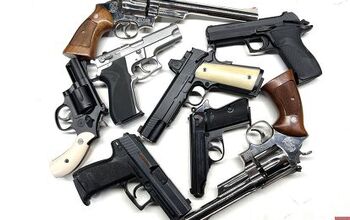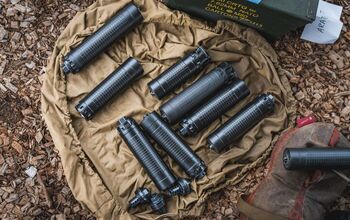The Rimfire Report: Klimovsk’s “Junior” .22 LR in the Green Box

Hello and welcome back to another edition of The Rimfire Report. In our weekly dive into the world of .22 LR and all things rimfire we’ll be taking a look this week at a piece of rimfire history with an overview of a somewhat elusive import from Russia: the “Junior” Sport-Hunting .22 LR ammunition, manufactured by the Klimovsk Specialized Ammunition Plant (KSPZ) and packaged in a distinctive green box. This week’s edition of Rimfire Report is extremely special to me, as this is one of the rare times I get to test out ammo that you, the readers, have sent to me. This week’s Green Box of Russian rimfire ammo comes courtesy of TFB reader Randall B. Big thank you to Randall B for sending this sample of ammo in!
More Rimfire Report Articles @ TFB:
- The Pint-Sized GOAT-15 Gen3 Pistol from Mountain Billy Gun Lab
- The Rimfire Report: A Retrospective on the KelTec P17 Pistol
- The Rimfire Report: A Closer Look at the “New” HK G36 22LR
The Rimfire Report: Klimovsk’s “Junior” .22 LR in the Green Box
The Klimovsk Specialized Ammunition Plant, located near Podolsk, in sort of near Moscow, has been churning out ammunition since 1936. Originally known as the “Novopodolsky” plant (factory number 711), KSPZ played a significant role in Soviet ammunition production, supplying everything from 7.62x39mm military rounds to precision .22 LR for Olympic shooters and biathletes. One interesting thing to note is that there are currently open sanctions against this particular Russian company, probably for reasons that are beyond obvious.
Enter the “Junior” Sport-Hunting .22 LR, one of Klimovsk’s more affordable lines aimed at recreational shooters and hunters. After the Soviet Union’s collapse, Klimovsk’s products, including their .22 LR offerings, found their way to Western markets, particularly the U.S., where they became a staple of the 1990s gun show scene according to a healthy sampling of forum postings. I’m not sure how Randall came across this box, but he’s kept it in quite good condition, as you can see from the photos.
Packaged in a light green box featuring a small rooster logo (or other small animals, this is an ongoing debate), this ammo was marketed as a budget-friendly option for plinking, small game hunting, and casual target practice. While KSPZ was known for high-end match-grade rimfire ammo used in international competitions, Junior was the everyman’s choice, offering decent performance at a price that didn’t break the bank and could be had at a frugally minded price.
What’s in the Green Box?
From all the data I’ve been able to gather, the Junior .22 LR came in two primary variants: brass-cased and steel-cased, with the latter being more common in the green-box packaging and our example for today, as opposed to the brass cases, which came in a yellow box. Aside from the case difference, I couldn’t 100% confirm there were any other major differences between the two offerings, but they likely used the same bullet or likely went through a more stringent loading and quality control process.
Standard 40-grain lead round nose (LRN) bullets were typically coated with a waxy lubricant to reduce barrel fouling, similar to Western nations' 22LR. The wax that was on these rounds has since degraded and mostly either flaked off or pooled at the tip of the bullet from years of sitting in their tip-down position. Some collectors and other forum posters have noted that the steel-cased ammunition can have corrosion or white film on the outside from exposure to moisture and the elements, but our example box for today is in relatively pristine condition.
According to a few online sources, Junior brass-cased 22LR was praised for reliability and decent accuracy, with users saying these were comparable to mid-tier Western ammo like Eley Sport or CCI Green Tag. The steel-cased variant, on the other hand, was and is more budget-oriented and, as a result, was more heavily lubricated, often leaving a greasy or waxy residue that could gunk up actions, which I fully expect to happen when we go to test this ammo. Extraction issues were reported in some firearms, particularly semi-autos or rifles with tight chambers.
The steel-cased rounds often lack a headstamp or feature a simple “V” marking, while brass-cased versions might include more detailed stamps. However, the “V” marking on the steel-cased Klimovsk Junior .22 LR ammunition, interestingly enough, most likely stands for Vostok, the brand under which KSPZ produced and exported much of its .22 LR, including the budget Junior line.
The Good, the Bad, and the Greasy
Junior ammo earned a mixed reputation among modern American collectors and shooters. The brass-cased version was well-regarded, with some enthusiasts claiming it rivaled pricier Western brands in bolt-action rifles or Russian-designed firearms like the CM-2 or Biathlon Basic. Its accuracy was respectable for casual shooting, and its affordability made it a go-to for range days when it was fairly inexpensive during the early 90s.
One interesting tidbit: Russian .22 LR, including Klimovsk’s match-grade offerings, was reportedly studied by U.S. manufacturers like Federal in the 1990s after Soviet Olympic ammo was “borrowed” during competitions. The consistent priming (achieved via dimpled cases) was a standout feature, hinting at KSPZ’s technical prowess, even if Junior was a humbler product. This is a trend that somewhat follows today with American rimfire cases largely using “spun brass” priming versus European countries, which more often than not use a pressing method to ensure even distribution and ignition in 22LR’s primer rim.
If you’ve got a stash of Junior ammo, check its condition before shooting. Old batches may show corrosion or degraded propellant, especially if stored poorly. Steel-cased rounds are riskier in modern firearms, so test them in a bolt-action or single-shot rifle first, and keep a cleaning rod handy. Brass-cased Junior, on the other hand, might still deliver surprisingly good results for its age. We’ll for sure be keeping a brass rod on standby when we go to test this ancient ammo.
Initial Thoughts + Testing Ahead
Junior ammo was apparently a common sight in the U.S. during the 1990s, sold by distributors like J&G Sales or at gun shows for bargain prices. However, imports slowed after the early 2000s, and by 2024, Klimovsk’s .22 LR production appears to have tapered off, possibly due to the plant’s nationalization by the Russian government. Surplus boxes still pop up occasionally, and well-preserved brass-cased Junior can fetch $50–$55 per 500-round brick among collectors or nostalgic shooters on Gunbroker or similar websites. I have no way to estimate how much a box would have cost you during the era of the USSR as a Russian citizen wanting to buy some ammo for shooting small game.
The Klimovsk Junior .22 LR in its green box is probably the most unique box of old rimfire ammo I’ve been able to get my hands on. It’s quite an interesting, allegedly budget-friendly import that brought Russian engineering to Western shooters during a unique era. While it may not match the modern consistency of new-production ammo like SK Standard Plus, Lapua Biathlon, Eley TenX, or Federal Gold Medal, its affordability and status as a product from a bygone era make it an interesting collector's piece too.
Stay tuned for a future Rimfire Report where we’ll put Junior to the test, measuring velocities, accuracy, and reliability in our typical testbed, the Bergara B14R. In the meantime, if you’ve shot Junior or have a green box gathering dust, let us know your experiences in the comments! Did you love its bang-for-buck value, or did the greasy steel cases leave you cursing? Until next time, keep those .22s humming, and we’ll see you at the range! Be sure to thank Randall in the comments if you found this rare sampling of 22LR interesting.

Reloader SCSA Competitor Certified Pilot Currently able to pass himself off as the second cousin twice removed of Joe Flanigan. Instagram: https://www.instagram.com/ballisticaviation/
More by Luke C.

























![[SHOT 2025] March Scopes Displays PRS-optimized Scope](https://cdn-fastly.thefirearmblog.com/media/2025/01/23/10591/shot-2025-march-scopes-displays-prs-optimized-scope.jpg?size=350x220)










Comments
Join the conversation
I have a case and a few bricks of this stuff, decent ammo and dirt cheap at the time.
Yea I still have about 5000 rds of this junk, 1.2 cents per rd, 1991, bought 10,000 rds, mine was very inconsistent, I'm saving it for barter end of days